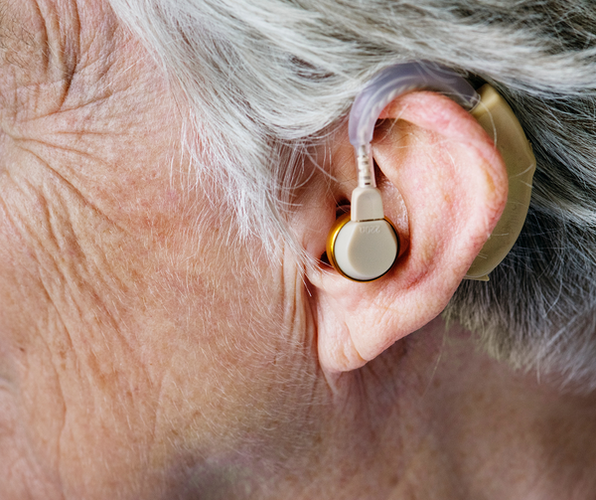Veterans and hearing loss
One of the most dangerous places in the world is the flight deck of an aircraft carrier. But the hazards involve more than tons of live ordnance, dodging spinning propellers, and avoiding rivers of flame from fighter jet afterburners. It is also the loudest environment in which I ever worked as a Navy technician during the Cold War.
People rarely think of hearing loss as a military risk when, in truth, it is pervasive. Flight decks, small arms fire, artillery, explosions, and myriad other sources of high-decibel noise pose an ever-present threat to men and women in uniform. This fact came into sharp relief for me 25 years after leaving the military when I served as a deputy assistant secretary for the U.S. Department of Veterans Affairs. It was only then that I realized the true scale and cost of hearing loss.
 Two of the most prevalent injuries among veterans are hearing loss and tinnitus. In 2018, as many as 1,228,936 veterans suffered from hearing loss. Another 1,971,201 suffer from tinnitus, and these numbers continue to rise every year. Thankfully, the Pentagon recognizes this problem and is studying innovative ways to protect service members so they don't become another statistic in the growing list of veterans suffering from hearing loss and tinnitus.
Two of the most prevalent injuries among veterans are hearing loss and tinnitus. In 2018, as many as 1,228,936 veterans suffered from hearing loss. Another 1,971,201 suffer from tinnitus, and these numbers continue to rise every year. Thankfully, the Pentagon recognizes this problem and is studying innovative ways to protect service members so they don't become another statistic in the growing list of veterans suffering from hearing loss and tinnitus.
The Centers for Disease Control and Prevention found that veterans are 30 percent more likely than non-veterans to have a severe hearing impairment, which has a lasting effect on their daily lives. Hearing loss means much more than simply asking people to repeat themselves. It can cause mental and social problems including depression, anxiety, low self-esteem, isolation and withdrawal, reduced social activity, and problems at work. I was struck by the story of one Florida vet who admitted feeling lost and isolated because his hearing loss caused him to pretend to hear others when he actually couldn't. That happens to me sometimes, and some of my military buddies, too.
These injuries have real monetary costs to veterans as well. One study found that hearing loss can result in as much as $279,000 in lost lifetime income. With dwindling personal finances and an inability to effectively communicate, veterans are being set up to fail in civilian life, all because of a preventable injury.
To combat the rising rates of hearing loss and tinnitus among active-duty military personnel and veterans, the Department of Defense launched a hearing conservation program (HCP). The program educates military members on the importance of protecting their hearing and the lifelong effects if they do not. But education goes only so far. The military has an obligation to equip war-fighters with hearing protection that offers safety while providing communications efficiency in combat scenarios.
Past efforts to provide this protection have fallen short. One defense contractor, the 3M Company, put thousands of soldiers at risk with faulty earplugs that allowed dangerous levels of noise to come through, making users susceptible to hearing damage. The messy result is that hundreds of veterans have joined a lawsuit against the company after a previous settlement between 3M and the federal government left veterans out of the equation.
One encouraging thing to come out of all this is that it has sparked change, and Congress has initiated a search for better devices to protect hearing. In 2018, the House Committee on Armed Services shared a quality report that listed a number of viable options for new and improved hearing protection. That's good news, but now it's time to follow through.
Many military wounds are unavoidable, but hearing loss is not one of them. We must provide the best protection available to those who wear the uniform and seek to ensure they have a good quality of life when they come back home. Anything less is a betrayal of those who volunteer to put themselves in harm's way.
Scott Hogenson served as deputy assistant secretary for public affairs at the U.S. Department of Veterans Affairs in the George W. Bush administration.
FOLLOW US ON
Recent Articles
- Deep Dive: The Signal Chat Leak
- Mark Steyn’s Reversal of Fortune
- Where We Need Musk’s Chainsaw the Most
- Trump Is Not Destroying the Constitution, but Restoring It
- The Midwest Twilight Zone and the Death of Common Sense
- Hijacked Jurisdiction: How District Courts Are Blocking Immigration Enforcement
- Transgender Armageddon: The Zizian Murder Spree
- Jasmine Crockett, Queen of Ghettospeak
- The Racial Content of Advertising
- Why Liberal Judges Have a Lot to Answer For
Blog Posts
- Amid disaster, watch Bangkok clean up and rebuild
- Katherine Maher shoots herself, and NPR, in the foot
- A visit to DOGE
- You just might be a Democrat if ...
- Yahoo Finance writer says Trump’s tariffs will see America driving Cuban-style antique cars
- Kristi Noem and the prison cell
- Dividing the Democrats
- April 2nd: Liberation Day and Reconciliation Day don’t mix
- Red crayons and hospital gowns
- The Paris Climate Agreement was doomed from the start
- Well excuse me, I don't remember
- Bill Maher goes civil
- Mass shootings: we're all survivors!
- Tesla and a second
- Snow White: a bomb for the ages






